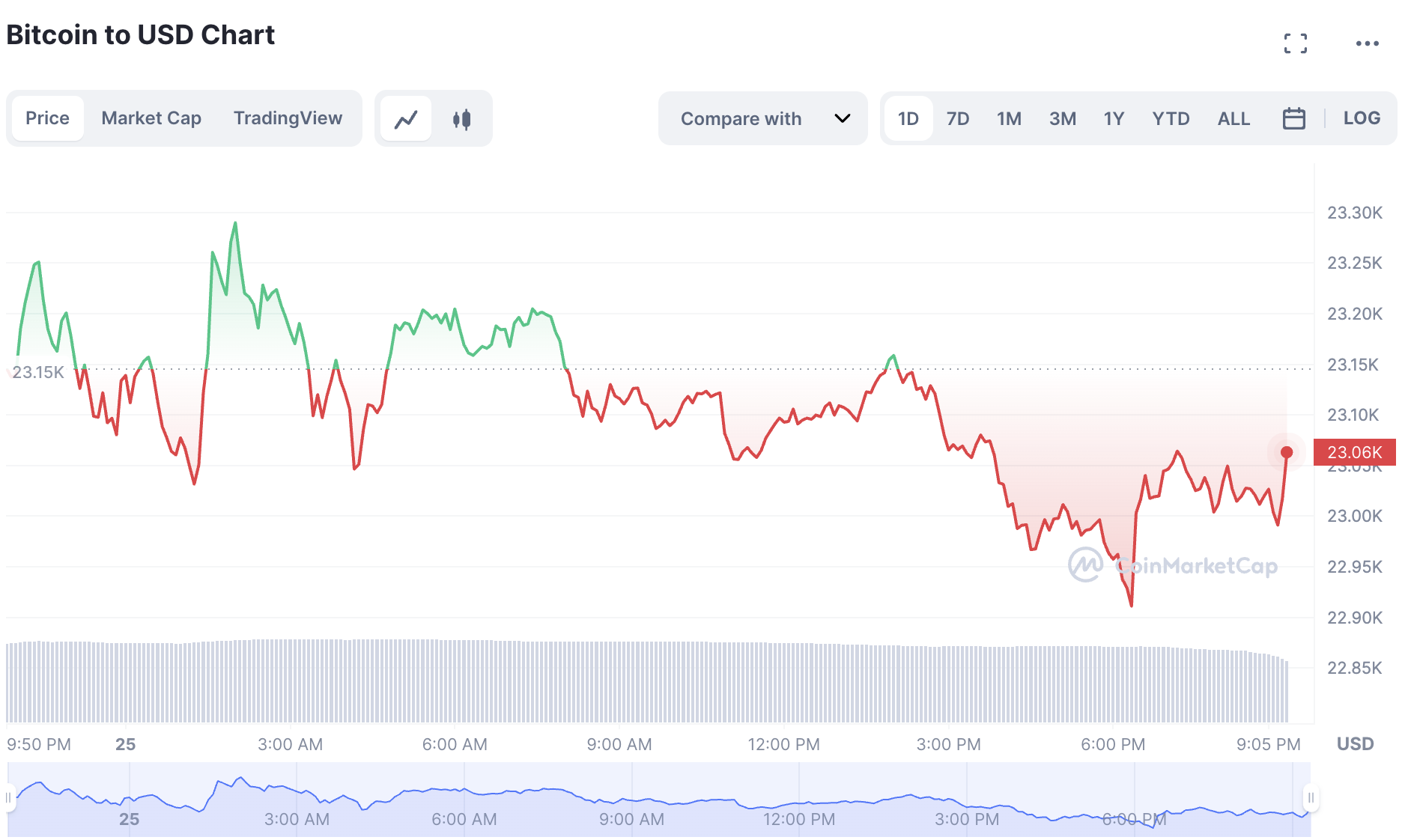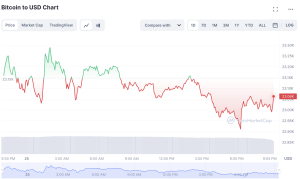Join Our Telegram channel to stay up to date on breaking news coverage
Bitcoin underwent a bearish swing on the 21st and consecutively 24th of February, correcting to $23,100 at the time of writing. The last 24 hours have been particularly discouraging for buyers as the token lost over $1000 dollars, with a decrease in trading volume of 11%.
This bearish impression has been observed throughout the market, as Bitcoin turns its support at $23,100 into a resistance. Up until the evening of the 24th, Bitcoin was well above its resistance of $23,739, which has been attributed to buyers participating in the market as they help prevent further losses.
The Bitcoin price was predicted to undergo a downtrend if the price levels didn’t pick up from the above-mentioned resistance level. Had it shown some upwards momentum, bitcoin could’ve possibly challenged $24,267 and headed towards $25,000.
Price analysis of the token suggests that buyers will need to break this level if the token is to gain bullish momentum. Once the token price crosses its high on the 24th, investors can expect a rebound that could clear this week’s losses.
Inflation Anxiety Pulls Bitcoin To a Weekly Low
Market participants are increasingly expecting the US Federal Reserve to hike its benchmark fed funds rate by 50 basis points next month after the PCE Price Index displayed a disinflation trend settling in January.
The price index for January rose 5.4% when compared to last year, which was much greater than forecasts from economists who predicted the token to mark an increase of 5%. On a monthly basis too, the PCE Price Index outperformed its expectations, gaining 0.6% in January, while the predictions had it at 0.5%.
The core rate for the metric, which excludes energy and food prices, increased by 4.7% in January as opposed to 4.6% in December. Estimates for these figures projected an increase of 4.3%. This report caused a price decline among risky assets such as cryptocurrencies, where bitcoin fell by about $200 initially, and consequently dropped to $23,100. Currently, the token is challenging $23,000, which would be the lowest level of Bitcoin this week.
Crypto-related stocks including MicroStrategy and Coinbase too are down by about 5-8%. While Nasdaq 100 futures were down 1.72% on Saturday, and S&P 500 futures had gone down by 1.1%, at the time of writing.
The Fed has been looking at personal consumer expenditure as the primary indicator to assess Inflation. The odds of the inflation increasing by 50 basis points are on the rise as opposed to an estimate of 25 basis points in January, leaving traders completely divided over cryptocurrencies performance over the near short term.
Margin Longs Defend $24k As Optional Traders Remain Confident With Downside Risks
Margin markets help understand the position of professional traders in the market, as investors can leverage their cryptocurrency positions by borrowing extra cryptocurrencies. Investors can, for example, increase their exposure to Bitcoin by borrowing cryptocurrency and going for a long position.
Bitcoin’s margin lending ratio increased between Feb 21st and 23rd, indicating that advanced traders were leveraging long positions as the price fell below $24,000. Which helped sustain the price of the token for a while, although the skepticism around rising inflation rates triggered a price decline soon after.
Options markets, on the other hand, can help assess how risk-averse investors are, while the 25% delta skew signals overcharge for upside or downside protection by market makers. The indicator turns positive with an increase in fear. So a 10% increase will suggest a Bitcoin crash, while a 10% drop will signal excitement.
The chart above suggests an executive demand for margin longs while the risk assessments from options traders remain neutral. Bitcoin derivatives are holding up quite nicely considering the pressure from regulators, indicating a positive outlook for the token in the short term.
Will Bitcoin Undergo An Upswing After Rebalance of 15 February Surge?
The price of bitcoin currently stands at $23,148, with a trading volume of $24.8 billion over the last 24 hours. The price has decreased by 2.77% in the last 24 hours, and the market cap for the token remains at $446 billion.
Bitcoin broke its support at $23,600 but successfully bounced back from the $23,100 level, with $23,375 as its next resistance. Bitcoin will have to cross this resistance, and successfully break $24,100 if it plans to reach $24,500 and consequently head for $25,000.
RSI & MACD indicators are still in the selling zone for now, and the $23,600 and $23,350 levels will play an important hand in deciding the token’s short-term trajectory. Once the prices go above these levels, bitcoin will present a buying opportunity for investors, potentially undergoing a short rally.
Related Articles
Best Wallet - Diversify Your Crypto Portfolio
- Easy to Use, Feature-Driven Crypto Wallet
- Get Early Access to Upcoming Token ICOs
- Multi-Chain, Multi-Wallet, Non-Custodial
- Now On App Store, Google Play
- Stake To Earn Native Token $BEST
- 250,000+ Monthly Active Users
Join Our Telegram channel to stay up to date on breaking news coverage


